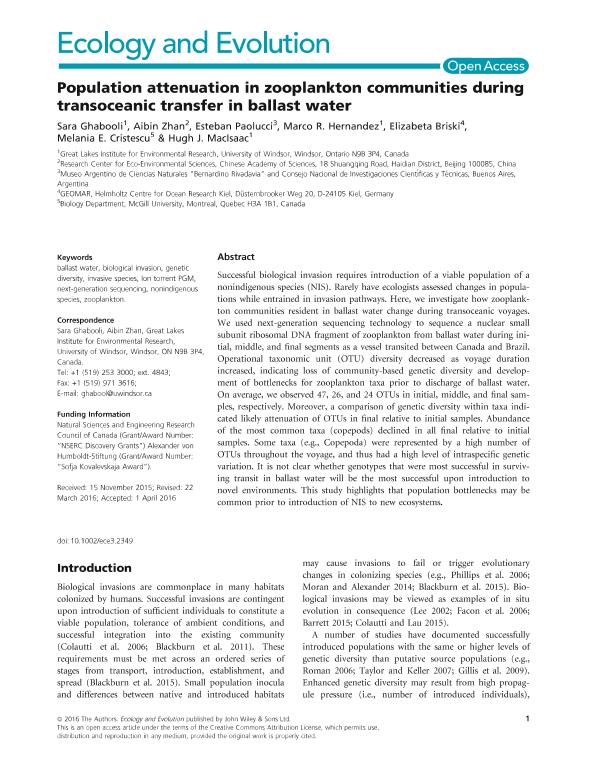Artículo
Population attenuation in zooplankton communities during transoceanic transfer in ballast water
Ghabooli, Sara; Zhan, Aibin; Paolucci, Esteban Marcelo ; Hernández, Marco R.; Briski, Elizabeta; Cristescu, Melania E.; MacIsaac, Hugh J.
; Hernández, Marco R.; Briski, Elizabeta; Cristescu, Melania E.; MacIsaac, Hugh J.
 ; Hernández, Marco R.; Briski, Elizabeta; Cristescu, Melania E.; MacIsaac, Hugh J.
; Hernández, Marco R.; Briski, Elizabeta; Cristescu, Melania E.; MacIsaac, Hugh J.
Fecha de publicación:
09/2016
Editorial:
Wiley
Revista:
Ecology and Evolution
ISSN:
2045-7758
Idioma:
Inglés
Tipo de recurso:
Artículo publicado
Clasificación temática:
Resumen
Successful biological invasion requires introduction of a viable population of a nonindigenous species (NIS). Rarely have ecologists assessed changes in populations while entrained in invasion pathways. Here, we investigate how zooplankton communities resident in ballast water change during transoceanic voyages. We used next‐generation sequencing technology to sequence a nuclear small subunit ribosomal DNA fragment of zooplankton from ballast water during initial, middle, and final segments as a vessel transited between Canada and Brazil. Operational taxonomic unit (OTU) diversity decreased as voyage duration increased, indicating loss of community‐based genetic diversity and development of bottlenecks for zooplankton taxa prior to discharge of ballast water. On average, we observed 47, 26, and 24 OTUs in initial, middle, and final samples, respectively. Moreover, a comparison of genetic diversity within taxa indicated likely attenuation of OTUs in final relative to initial samples. Abundance of the most common taxa (copepods) declined in all final relative to initial samples. Some taxa (e.g., Copepoda) were represented by a high number of OTUs throughout the voyage, and thus had a high level of intraspecific genetic variation. It is not clear whether genotypes that were most successful in surviving transit in ballast water will be the most successful upon introduction to novel environments. This study highlights that population bottlenecks may be common prior to introduction of NIS to new ecosystems.
Archivos asociados
Licencia
Identificadores
Colecciones
Articulos(MACNBR)
Articulos de MUSEO ARG.DE CS.NAT "BERNARDINO RIVADAVIA"
Articulos de MUSEO ARG.DE CS.NAT "BERNARDINO RIVADAVIA"
Citación
Ghabooli, Sara; Zhan, Aibin; Paolucci, Esteban Marcelo; Hernández, Marco R.; Briski, Elizabeta; et al.; Population attenuation in zooplankton communities during transoceanic transfer in ballast water; Wiley; Ecology and Evolution; 6; 17; 9-2016; 6170-6177
Compartir
Altmétricas



